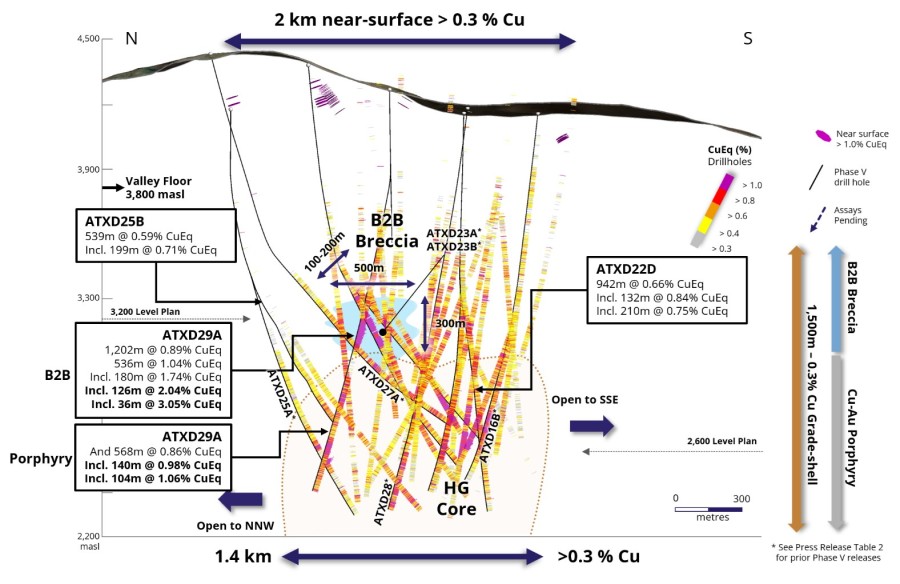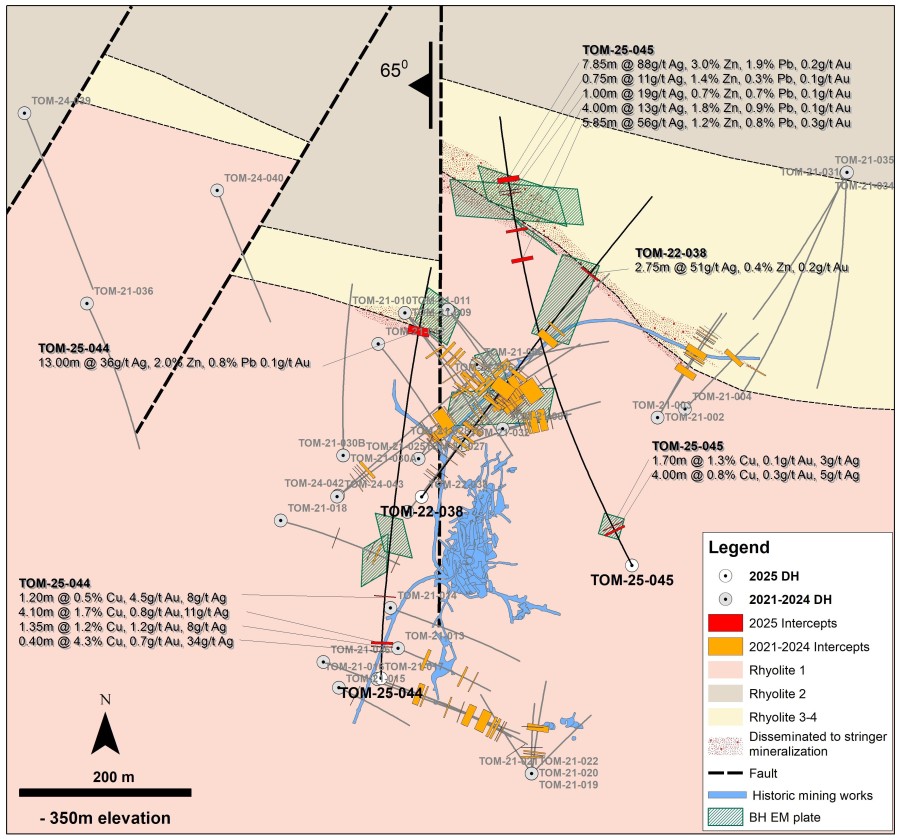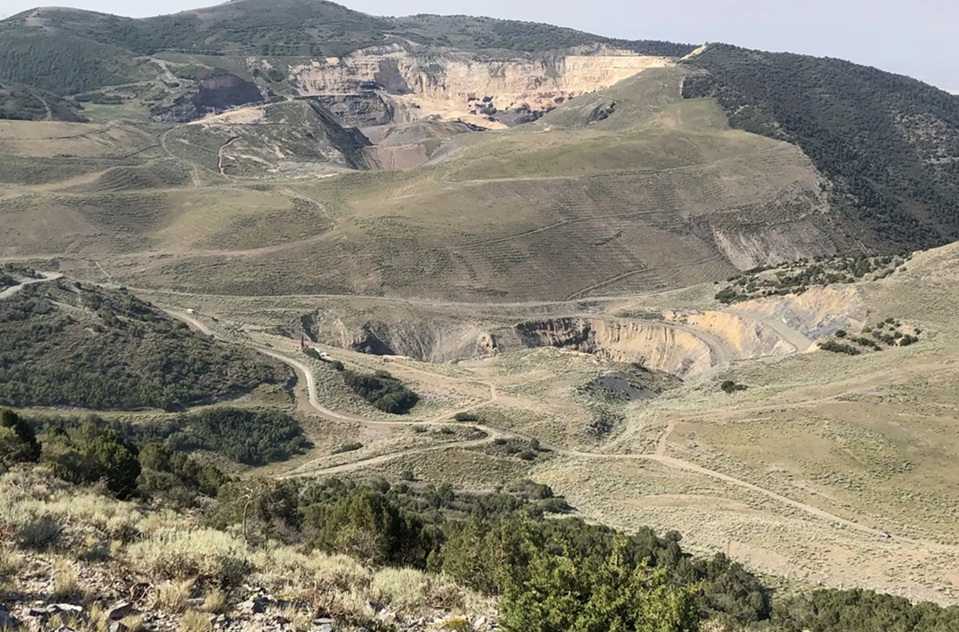VANCOUVER, British Columbia, Nov. 14, 2017 (GLOBE NEWSWIRE) -- North American Nickel Inc. (TSX VENTURE:NAN) (OTCBB:WSCRF) (CUSIP:65704T 108) (the "Company") is pleased to report that assays have been received from three drill holes completed to test the P-013 SE target on the Company’s 100% owned Maniitsoq nickel-copper-cobalt-PGM sulphide project in southwest Greenland.
Highlights include:
- MQ-17-140: 20.85m @ 0.65% Ni, 0.47% Cu, 0.02% Co and 0.38 g/t Pt+Pd+Au including
- 14.25m @ 0.75% Ni, 0.64% Cu, 0.02% Co and 0.52 g/t Pt+Pd+Au and
- 1.20m @ 1.65% Ni, 0.12% Cu, 0.04% Co and 0.19 g/t Pt+Pd+Au
- MQ-17-142: 5.70m @ 0.50% Ni, 0.51% Cu, 0.02% Co and 0.79 g/t Pt+Pd+Au
- Drilling has extended the known mineralization by 140 metres in a down dip direction; P-013 SE is considered to be open down dip and along strike.
- Mineralization is characterized by high nickel tenors and elevated copper and precious metal values.
- Drilling and borehole electromagnetic results show that the P-013 SE zone is comprised of both high grade remobilized sulphides and disseminated to blebby sulphides which is typical of the Maniitsoq style of mineralization.
- P-013 SE is located 225m southeast of the P-013 Centre zone where the Company’s previous drilling intersected grades of up 11.0m @ 1.31% nickel and 0.15% copper including 5.85m @ 2.07% nickel and 0.12% copper.
- P-013 area represents another significant location within the 75km long Greenland Norite Belt where multiple zones of Maniitsoq type sulphide mineralization have now been identified.
NAN CEO, Keith Morrison, commented: “NAN’s drilling objectives in 2017 were to efficiently determine the size potential and continuity of each complete mineralized system (including everything from disseminated to massive mineralization). In drilling down dip step-outs we often aim at the edges of, or below, conductive plates that we know will contain higher grade mineralization, in-order to get a deeper and better evaluation of the down-dip continuity of the entire system. It is important to recognize that these results, while very good, do not represent the best mineralization at P-013 SE. At P-013 SE, the system has both untested high conductance BHEM plates and open down dip potential to be evaluated with future drilling. These new results continue to demonstrate the multiple sulphide lens style and prospectivity of the Maniitsoq project.”
Six holes totalling 1,331 metres were completed at the P-013 SE target located 9 km south of the Fossilik area in the central portion of the Greenland Norite Belt (Figure 1). The initial three holes were abandoned due to drilling problems and an additional three holes were completed to target depth. This release summarizes the results received for the latter three holes totalling 1,073 metres. Drill collar information and a summary of assays are provided in Tables 1 and 2 respectively. A drill plan map is provided in Figure 2 and a vertical cross section is shown in Figure 3. Figures may be viewed using the link provided with this release.
Further details of the drilling completed at P-013 SE are given below.
In 2016, high grade nickel sulphides were discovered at the P-013 SE target while testing a borehole electromagnetic (BHEM) anomaly. The mineralization in drill hole MQ-16-109 consisted of norite-hosted remobilized massive sulphide stringers, veins and breccia veins assaying 2.88% Ni and 0.80% Cu over a core length of 13.35 metres (see News Release dated October 26, 2016).
In 2017, step-out drilling was carried out to test the down dip extent of the P-013 SE mineralization (see Figure 2). The first drill hole, MQ-17-138, intersected a 53 metre interval of norite from 229 metres to 282 metres but did not contain significant mineralization. Based on BHEM results, this hole is interpreted to have been drilled off to the side of the zone. Two additional holes intersected nickel sulphide mineralization.
Table 1: Drill Collar Information, P-013 SE
| Hole Number | UTM East | UTM North | Elevation (m) | Length (m) | Azimuth | Dip |
| MQ-17-134* | 475348 | 7239587 | 304 | 149.40 | 316 | -52 |
| MQ-17-136** | 475348 | 7239587 | 304 | 8.00 | 313 | -54 |
| MQ-17-137*** | 475346 | 7239589 | 304 | 101.00 | 313 | -54 |
| MQ-17-138 | 475348 | 7239590 | 304 | 326.00 | 314 | -54 |
| MQ-17-140 | 475372 | 7239644 | 307 | 299.00 | 310 | -55 |
| MQ-17-142 | 475373 | 7239643 | 307 | 448.00 | 318 | -65 |
Note: Collar coordinates in UTM WGS84 Zone 22N
Abandoned Holes:
* Hole lost at 149.4m
** Hole lost at 8m in casing
*** Hole lost at 101m
Table 3: Assay Results, P-013 SE
| Hole Number |
From (m) |
To (m) |
Core Length (m) |
Ni% | Cu % | Co % | S % | Pt g/t |
Pd g/t |
Au g/t |
||
| MQ-17-138 | NSA | |||||||||||
| MQ-17-140 | 247.35 | 268.20 | 20.85 | 0.65 | 0.47 | 0.02 | 2.77 | 0.11 | 0.05 | 0.22 | ||
| incl. | 247.35 | 261.60 | 14.25 | 0.75 | 0.64 | 0.02 | 3.35 | 0.15 | 0.07 | 0.30 | ||
| and | 267.00 | 268.20 | 1.20 | 1.65 | 0.12 | 0.04 | 5.61 | 0.05 | 0.09 | 0.05 | ||
| MQ-17-142 | 298.00 | 303.70 | 5.70 | 0.50 | 0.51 | 0.02 | 2.48 | 0.07 | 0.06 | 0.66 | ||
| 316.91 | 317.50 | 0.59 | 0.72 | 0.27 | 0.02 | 2.89 | 0.03 | 0.25 | 0.02 | |||
| 431.30 | 438.45 | 7.15 | 0.23 | 0.09 | 0.01 | 0.88 | 0.06 | 0.01 | 0.06 | |||
| incl. | 431.55 | 432.45 | 0.90 | 0.59 | 0.29 | 0.02 | 2.57 | 0.24 | 0.03 | 0.12 | ||
Note: Intervals represent core lengths, not necessarily true widths.
NSA – No Significant Assays
Hole MQ-17-140 was targeted using BHEM results from hole MQ-17-138 and intersected a wide zone of norite-hosted disseminated, patchy and remobilized breccia sulphides grading:
- 0.65% nickel, 0.47% copper and 0.38 g/t Pt+Pd+Au over 20.85 metres from 247.35 to 268.20 metres including:
- 0.75% nickel, 0.64% copper and 0.52 g/t Pt+Pd+Au over 14.25 metres and
- 1.65% nickel, 0.12% copper and 0.19 g/t Pt+Pd+Au over 1.20 metres
The mineralization in MQ-17-140 is located 65 metres down dip of MQ-16-109 and a highly conductive trend is situated between the two holes as shown by the modeled BHEM plates in Figure 2. These BHEM plates are interpreted to represent the continuation of the high grade sulphides intersected in MQ-16-109.
Hole MQ-17-142 was a down dip step out hole targeted along the projected trend of BHEM anomalies but not targeting a specific modeled BHEM plate. This hole intersected the interpreted extension of the sulphide zone 75 metres down dip of MQ-17-140 and included:
- 5.7 metres of norite-hosted disseminated, blebby and fracture-controlled sulphides grading 0.50% nickel, 0.51% Cu and 0.79 g/t Pt+Pd+Au from 298.00 to 303.70 metres and
- a narrow interval of breccia sulphides grading 0.59% nickel, 0.72% copper and 0.30 g/t Pt+Pd+Au over 0.59 metres from 316.91 to 317.50 metres.
A subsequent BHEM survey detected a moderate conductance off-hole anomaly located between holes MQ-17-140 and MQ-17-142 indicating continuity of the zone between the holes. An additional sulphidic interval with elevated nickel-copper-precious metal values was intersected deeper in hole MQ-17-142 (see Table 2).
The P-013 SE sulphide zone dips steeply to the southeast and has been intersected by three holes over a dip extent of 140 metres (see Figure 3). This new zone is located approximately 225 metres southeast of the P-013 centre area which contains a steeply northwest dipping sulphide zone defined over a dip extent of 100 metres in previous drilling. Grades of up to 1.31% nickel and 0.15% copper over 11.0 metres including 2.07% nickel and 0.12% copper over 5.85 metres have been intersected at P-013 Centre in past drilling (see News Releases dated November 21, 2013; November 3, 2014; September 2, 2015; and November 10, 2015).
The P-013 SE zone is characterized by high nickel tenors typically ranging from 7.3 to 10.3% in 100% sulphides and containing elevated copper and precious metals values. Similar to other Maniitsoq sulphide zones, the overall footprint of the mineralization comprises both high grade remobilized sulphides which exhibit strong BHEM responses as well as disseminated to blebby sulphides with little or no BHEM response.
In addition to the Imiak Hill Complex and the Fossilik area, the P-013 area represents a third location within the Greenland Norite Belt where multiple zones of mineralization have now been identified.
Quality Control
The drilling was completed by Cabo Drilling Corp (Canada) utilizing two Atlas Copco S2 diamond drill rigs. Additionally, drilling completed in September included a Helí 1500 Marcotte drill rig sourced from Arctic Core Drilling A/S (Greenland) and manned by a drill crew from Forage-M3 Drilling (Canada). Drill core samples (36.5 mm BQ and 47.6 mm NQ) are cut in half by a diamond saw on site. Half of the core is retained for reference purposes. Samples are generally 1.0 to 1.5 metre intervals or less at the discretion of the site geologists. Sample preparation is completed at the GeoLAB Greenland ApS preparation lab in Nuuk, Greenland. Sample pulps are sent by air to the MS Analytical laboratory in Langley, BC, Canada. Blank samples and commercially prepared and certified Ni sulphide analytical control standards with a range of grades are inserted in every batch of 20 samples or a minimum of one per sample batch. Analyses for Ni, Cu and Co are completed using a sodium peroxide fusion preparation and ICP-ES finish (PER-700). Analyses for Pt, Pd, and Au are by fire assay (30 grams nominal sample weight) with an ICP-AES finish (FAS-113).
Technical Information; Qualified Person
The Company is not aware of any legal, political, environmental or other risks that could materially affect the potential development of the project other than those set out in its annual information form filed on www.sedar.com. Please see below under the heading "Cautionary Note Regarding Forward-looking Statements" for further details regarding risks facing the Company.
All technical information in this release has been reviewed and approved by Patricia Tirschmann, P.Geo, who is the Qualified Person for the Company and Vice President Exploration, North American Nickel Inc.
About North American Nickel
North American Nickel is a mineral exploration company with 100% owned properties in Maniitsoq, Greenland and Sudbury, Ontario.
The Maniitsoq property in Greenland is a Camp scale project comprising 2,985 square km covering numerous high-grade nickel-copper sulphide occurrences associated with norite and other mafic-ultramafic intrusions of the Greenland Norite Belt (GNB). The >75km-long belt is situated along, and near, the southwest coast of Greenland accessible from the existing Seqi deep water port with an all year round shipping season and abundant hydro-electric potential.
The Post Creek/Halcyon property in Sudbury is strategically located adjacent to the past producing Podolsky copper-nickel-platinum group metal deposit of KGHM International Ltd. The property lies along the extension of the Whistle Offset dyke structure. Such geological structures host major Ni-Cu-PGM deposits and producing mines within the Sudbury Camp.





